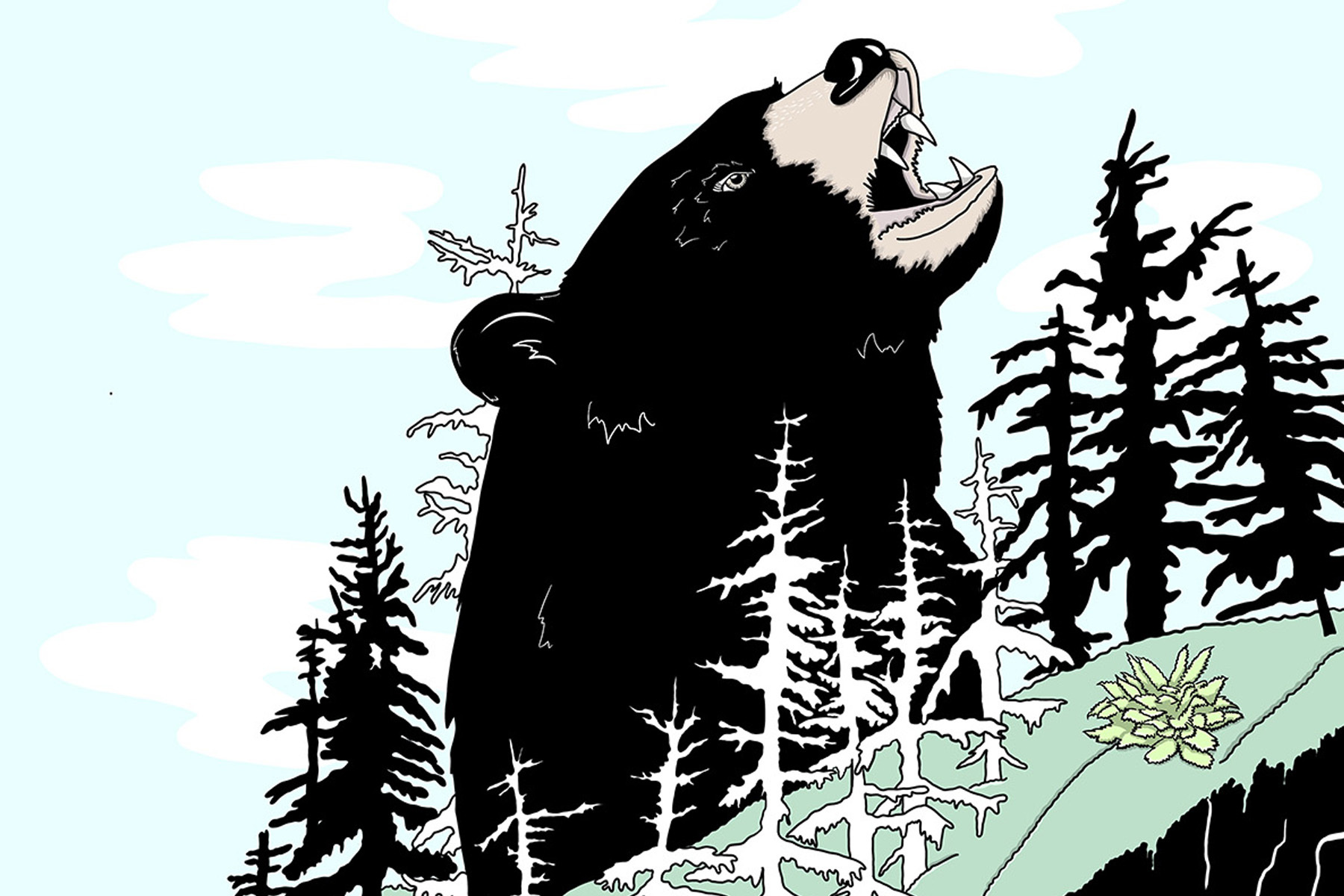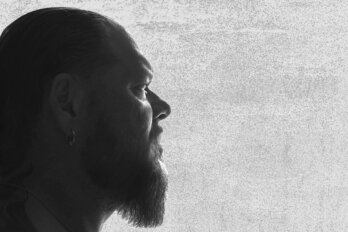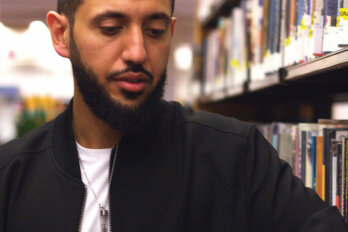Robed figures entered the room in silence and took their seats on the dais at the Supreme Court of Canada in regal movements. Lawyers fidgeted as our delegation of Ktunaxa elders, leaders, and youth packed into a stockade-like public gallery. The hour was early, but it felt as though the day had already passed. This was the place to be, and yet it was not the location where justice was found.
Some few thousand miles west, amid the hanging-glacier memories of kǂawǂa, deep in the snow fields where the Grizzly Bear Spirit goes to dance, a developer was determined to turn a millennia-old sacred space into a year-round skiing monstrosity known as the Jumbo Glacier Resort. The project had long been met with opposition. Some locals were less than enthusiastic about another ski resort when there were many options in the area. The Ktunaxa Nation rejected the proposal.
In response, in 2010, the Ktunaxa Nation shared vital cultural and spiritual knowledge with the province and the public in the form of the Qat’muk Declaration, which demonstrated the significance for the Ktunaxa of the area known as Qat’muk that included the proposed location of the resort. The Ktunaxa understand Qat’muk as the place where the Grizzly Bear Spirit goes to dance and respect it as a deeply sacred location. Cultural and spiritual knowledge is protected and scarcely shared outside of the nation. However, in the interest of protecting this place, the Ktunaxa Nation offered the Qat’muk Declaration. A delegation of Ktunaxa undertook a two-day journey from ʔamakʔis Ktunaxa to Victoria and hand-delivered the declaration to a BC MLA at a ceremony in the legislature.
In 2012, nearly a year and a half after receiving the Qat’muk Declaration from the Ktunaxa Nation, the province approved the project. The Ktunaxa Nation contested that decision and chose a legal path that would take years to reach a resolution. In late 2012, the Ktunaxa Nation filed an application for a judicial review of the province’s decision. At the heart of the case was the question of whether Indigenous sacred spaces and practices could be afforded protection under the Canadian Charter of Rights and Freedoms. The Ktunaxa argued that the approval of the resort by the province did not adequately consider the impact on Ktunaxa religious practices and beliefs, as the resort’s development would cause the Grizzly Bear Spirit to leave Qat’muk, irreparably damaging the sacred site.
The trial in the BC Supreme Court lasted two weeks in January 2014. That April, the court dismissed the Ktunaxa Nation’s application. The nation then applied to appeal that decision at the BC Court of Appeal. In 2015, that court dismissed the Ktunaxa Nation’s appeal. The following year, the Supreme Court of Canada agreed to hear the Ktunaxa Nation’s case.
After years of legal wrangling, court hearings, and appeals, as well as countless hours spent in community, talking with knowledge holders, elders, and leaders, the crafting of affidavits, and generations of ceremony and existence in ʔamakʔis Ktunaxa, we finally had a date at the Supreme Court of Canada. The nation, of which I am a member, had given a lot to that case and to the Canadian legal system. We were prepared for our day in court.
When the Supreme Court of Canada dismissed the Ktunaxa Nation’s appeal in 2017, it was not a surprise. In the court, the majority of judges failed to see how the building of a ski resort on a sacred space would violate the Ktunaxa’s right to religious freedom. While two judges did recognize this violation, they noted in a partially concurring decision that religious freedom had to be weighed against the provincial government’s mandate to dispense Crown land in the public interest. In the judges’ opinion, the province had made a reasonable decision.
That we had gotten that far was remarkable. Our path was indexed against the unique shadow of Canadian injustice called constitutional law that sweeps Indigenous peoples under in perpetuity. We were in the wrong place at a wrong time. When the chief justice of Canada began her incantation of introductions, she mispronounced our nation’s name and the name of our nation’s chair. Some of us would have expected basic understanding of a language they do not know, understand, or recognize—a language from a land they claim as their own and define and dispose as wilderness. These were simply words on a page that was soon to be dismissed and forgotten like a dry-cleaning bill for robes stained with denial.
Indigenous people in court face the same field of austere indifference and lethal judgment. Whether it is a courtroom consideration over the rights of Indigenous peoples who predate the constitutional roots of Canada by several millennia, or the perfunctory justice that incarcerates tens of thousands of Indigenous people each year, it makes little difference: our rights do not matter.
The Ktunaxa journey to justice began in the mountains. But these paths take many journeys. One new legal path to justice reached the courts last year, originating from a nation on the west coast of Vancouver Island, and it has the potential to pave a road for Aboriginal title claims across British Columbia.
The Nuchatlaht Nation is seeking declaration of Aboriginal title over a roughly 200 square-kilometre area that includes part of Nootka Island. In 2017, Walter Michael, the late Nuchatlaht Tyee Ha’wilth, or head chief, began the nation’s lawsuit for title and rights recognition at the BC Supreme Court. In a public statement, he relayed a familiar story of how the nation has spent many frustrating years in treaty discussions and other processes, in hopes of protecting its land and people. Michael noted that “successive governments have failed to give Nuchatlaht serious iisaak (respect) for their Rights and Title.” The Nuchatlaht have seen their territory marred by resource extraction that has “adversely impacted Nuchatlaht sacred land and food sources.”
The crux of the case is this: the Nuchatlaht argue that they exclusively occupied the land in 1846, when the British asserted sovereignty over the area, and that this fulfills the legal test for Aboriginal title. In its written argument, the province disagreed with the Nuchatlaht’s interpretation of the test, arguing that the existing law states that “the history of ancestors to the modern-day Nuchatlaht,” both before and after the date of sovereignty, is “very significant.” The province noted that “the evidence shows there were multiple independent and autonomous local groups using parts of the Claim Area at various times up to and after 1846.”
There are many terms used when describing Indigenous peoples and their rights in Canada. Some terms are defined by Indigenous people themselves, while other terms are used by settler society to define and control Indigenous peoples and lands. Today, “Indigenous” is the preferred term used internationally to describe peoples and nations who were present on territories claimed and colonized by settlers. In government, the arts, and the private sector, “Indigenous” is the widely accepted term. The government of Canada defines Indigenous peoples as including First Nations, Métis, and Inuit peoples. For some, Indigenous rights do not necessarily mean Aboriginal rights as defined by the government.
Among governments and the general public, there is much misunderstanding around how Aboriginal rights are defined. Section 35 of the Constitution Act, 1982, states:
35 (1) The existing aboriginal and treaty rights of the aboriginal peoples of Canada are hereby recognized and affirmed.
(2) In this Act, “aboriginal peoples of Canada” includes the Indian, Inuit and Métis peoples of Canada.
(3) For greater certainty, in subsection (1) “treaty rights” includes rights that now exist by way of land claims agreements or may be so acquired.
(4) Notwithstanding any other provision of this Act, the aboriginal and treaty rights referred to in subsection (1) are guaranteed equally to male and female persons.
The 2007 United Nations Declaration on the Rights of Indigenous Peoples (UNDRIP) is the internationally recognized standard of rights. However, Canadian governments have long resisted implementing the declaration, arguing that affirming UNDRIP’s standard would put too onerous a burden on the Crown in relation to Indigenous peoples by effectively providing Indigenous peoples with veto power that would fetter government discretion—that is, Crown authority. While BC recognizes UNDRIP on paper—through its 2019 Declaration on the Rights of Indigenous Peoples Act (DRIPA)—the province has failed to do so on the land. According to DRIPA, “Indigenous peoples have the right to the lands, territories and resources which they have traditionally owned, occupied or otherwise used or acquired.” The Nuchatlaht case is the first Aboriginal title case to enter the courts since the provincial government passed DRIPA.
Many major Supreme Court cases dealing with Indigenous rights in Canada have referenced section 35 and the definition of Aboriginal rights, but the question of what counts as Aboriginal rights has been debated both in and out of courts. They have been interpreted to include fishing rights, other harvesting rights, procedural rights such as consultation and accommodation, and rights to the land itself—as well as the queen matriarch of all rights, Aboriginal title.
Unlike most of Canada, the vast majority of British Columbia is not covered by treaties. The Crown does not have treaties with most First Nations in the province. This was a result of the province’s unwillingness to enter into treaty negotiations with Indigenous peoples, hoping and sincerely working toward our erasure. This approach lasted until the early 1990s. While a treaty process began in the early 1990s, it has only produced seven modern treaties. The slow and costly process has made final agreements a rare milestone. This lack of treaties creates uncertainty for the Crown when pursuing its interests in the province, as the certainty framework it relies on elsewhere in Canada is not available here.
At the heart of the matter is the question: What does section 35 mean? Provincial and federal counsel have argued that it is an empty box that does not contain any rights unless agreed to by the Crown or established by court decision. Conversely, Indigenous peoples, who have lived on these lands much, much longer than Canada has existed, have argued that section 35 is a full box of rights that Indigenous peoples possess, including Aboriginal title. The Crown continues to rely on the Doctrine of Discovery, the framework used by England, France, Spain, and Portugal that asserted that lands they stumbled upon were effectively empty at the time of “discovery.” Indigenous peoples recognize the doctrine as the legal, political, and moral fiction that it is.
Over the years, there have been challenges. One of the most significant Aboriginal title cases was the Supreme Court of Canada’s 2014 Tŝilhqot’in Nation v. British Columbia decision. The case was brought to the BC Supreme Court by the Xeni Gwet’in, a member band of the Tŝilhqot’in Nation in BC’s interior, which argued that they possessed clear Aboriginal title to an area within their territory. After years and years of court hearings, the Supreme Court of Canada ruled in favour of the entire Tŝilhqot’in Nation. Tŝilhqot’in Nation v. British Columbia was a landmark decision: the first declaration of Aboriginal title by any court in Canada in more than thirty years. While the court did not recognize Aboriginal title across the country, it provided precedent for future Aboriginal title cases to be brought to court.
Considering the more than two centuries of denial and erasure that every Indigenous community in British Columbia has faced, it is remarkable that every community has not launched numerous legal challenges already. Genocide and the prohibition on hiring lawyers to pursue Indigenous legal claims were the barricades that stopped an uncountable number of cases before they could take their first steps. But that barricade is cracking.
For the British Columbia government, it is easy to have cozy photo ops with happy Indigenous peoples. Those are the only faces allowed in the frame. Small modicums of resources positioned as revenue sharing are no panacea for poverty. But the NDP cannot be solely blamed for this. The previous Liberal governments franchised the playbook of playing Indigenous “consent” for reconciliation. Under their “New Relationship” policy, the province began engaging in economic revenue-sharing agreements, some of which were criticized by First Nations for being small and short term. These agreements seemed to punt questions of Aboriginal title and rights for short-term economic certainty. After generations spent facing denial, many First Nations took advantage of these opportunities. Still, the fundamental question of title has not been resolved. Systemic poverty and cultural genocide are the key ingredients to ignoring uncomfortable questions on who actually owns the nearly million square kilometres of land that forms the province.
The Nuchatlaht case can change this. If the nation is successful in having any portion of its Aboriginal title declared by the Supreme Court of British Columbia, what does that say for the approximately 200 other First Nations in the province that have yet to seek a declaration of title? With a BC Supreme Court decision on the horizon, the Nuchatlaht could be the first nation to apply the precedent-setting Tŝilhqot’in decision to have their Aboriginal title recognized. No matter the shifting goalposts of Indigenous rights policy in Canada and British Columbia, the tides are changing.
Not all paths to justice, though, have dimensions on Canadian soil. The dream of justice for all Indigenous peoples is simply that—a dream bled for in nights in remand and daydreamed about in never-ending inquests, negotiations, and otherwise unfriendly and unsafe parleys that Canadians pantomime as nation to nation.
A brief history of the colonial project that is Canada: the North-West Mounted Police, the robber barons, miners, lumber lords, land rustlers, priests, and pedophiles—all of those who have come to our lands under a Canadian sun—brought the reserve, the Indian agent, the denial of movement, the insistence on residential schools, the many, many, many deaths and fewer graves, and then a slow retrenchment of the same edifice of power in the new Indian Affairs mantra of reconciliation. That is what every court case is about—what every inquest, commission, panel, and Supreme Court case is serving: the abominable violence of Canadian justice.
Aboriginal rights and title are not songs we created. They are not from our traditions. They are overlaid onto the land by Canadian law, without origin in our laws or practices. Aboriginal rights and title are the proof that Canada—its laws and fantasies—is unassailably in control, from the West Coast to the Rockies and across the Canadian Shield and beyond. But the courage, determination, and action of one First Nation on Vancouver Island to have its Aboriginal title declared by a high court paves a necessary path to justice.




